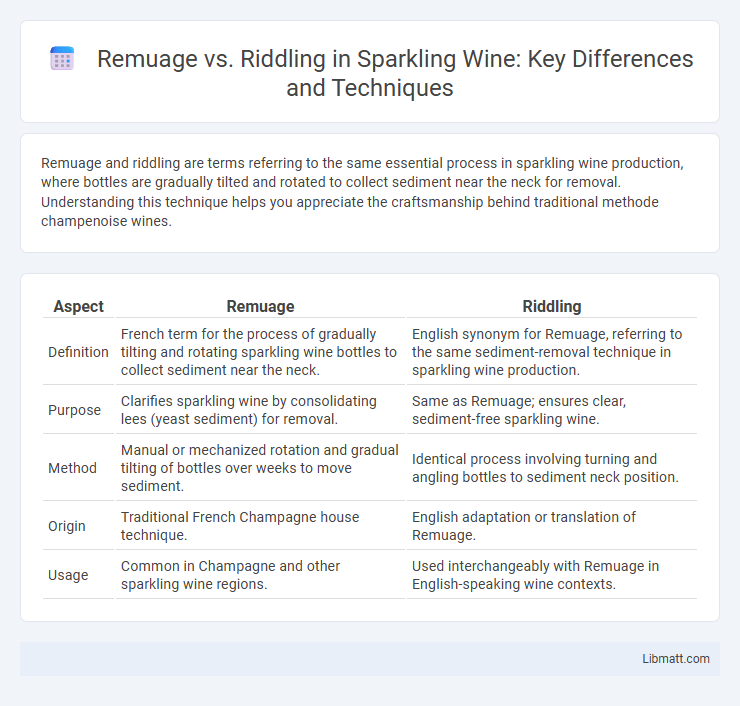Remuage and riddling are terms referring to the same essential process in sparkling wine production, where bottles are gradually tilted and rotated to collect sediment near the neck for removal. Understanding this technique helps you appreciate the craftsmanship behind traditional methode champenoise wines.
Table of Comparison
| Aspect | Remuage | Riddling |
|---|---|---|
| Definition | French term for the process of gradually tilting and rotating sparkling wine bottles to collect sediment near the neck. | English synonym for Remuage, referring to the same sediment-removal technique in sparkling wine production. |
| Purpose | Clarifies sparkling wine by consolidating lees (yeast sediment) for removal. | Same as Remuage; ensures clear, sediment-free sparkling wine. |
| Method | Manual or mechanized rotation and gradual tilting of bottles over weeks to move sediment. | Identical process involving turning and angling bottles to sediment neck position. |
| Origin | Traditional French Champagne house technique. | English adaptation or translation of Remuage. |
| Usage | Common in Champagne and other sparkling wine regions. | Used interchangeably with Remuage in English-speaking wine contexts. |
Introduction to Remuage and Riddling
Remuage and riddling are essential techniques in sparkling wine production used to clarify the wine by gradually moving sediment toward the bottle neck. Remuage, the French term, typically refers to the manual process involving turning and tilting bottles on a pupitre, while riddling can encompass both manual and mechanized methods such as gyro-palettes. These processes ensure sediment removal without disturbing the wine's effervescence, a critical step in traditional Champagne and other sparkling wines.
Historical Origins of Remuage and Riddling
Remuage and riddling both originated in the Champagne region of France as essential techniques for clarifying sparkling wine by consolidating sediment near the bottle neck. These methods evolved in the early 19th century, with Remuage credited to Madame Veuve Clicquot, who pioneered the process to improve the dosage removal efficiency. Understanding your sparkling wine's clarity involves appreciating these historical practices that transformed traditional winemaking.
Purpose: Why Remuage and Riddling Matter in Sparkling Wine
Remuage and riddling are essential techniques in sparkling wine production that remove sediment from the bottle to ensure clarity and enhance flavor purity. These processes gradually shift and collect lees near the bottle's neck, preventing cloudiness and off-flavors in your glass. Proper execution preserves the wine's crisp texture and visual appeal, central to the sparkling wine experience.
Traditional Remuage: Manual Techniques
Traditional remuage in sparkling wine production involves manual techniques where skilled workers carefully rotate and tilt bottles daily to gradually collect sediment near the bottle neck. This hands-on process preserves the delicate carbonation and ensures clarity without mechanical intervention. Your appreciation of authentic Champagne can be enhanced by understanding the craftsmanship behind this time-honored method.
Modern Riddling: Automated Gyropalettes
Modern riddling revolutionizes the traditional Remuage process by using automated gyropalettes, which efficiently rotate sparkling wine bottles to consolidate sediment near the neck. This mechanized technique drastically reduces labor and time while ensuring consistent clarity and quality in your sparkling wine. Gyropalettes optimize sediment removal, enhancing production scalability for Champagne and other sparkling varieties.
Key Differences: Remuage vs Riddling
Remuage and riddling both refer to the process of gradually tilting and rotating sparkling wine bottles to collect sediment near the neck for removal, but remuage is the traditional French term specifically linked to the Champagne method, while riddling is its broader English equivalent. The key difference lies in technique and historical context; remuage often involves manual work using a pupitre rack, whereas riddling can also include mechanical gyropalettes for efficiency. Your choice between remuage and riddling impacts the wine's clarity and quality, with remuage seen as artisanal and riddling as adaptable for larger scale production.
Impact on Wine Quality and Clarity
Remuage and riddling both play crucial roles in enhancing the clarity and quality of sparkling wine by facilitating the removal of sediment from the bottle. Remuage, a traditional hand-twisting method, allows more precise control over sediment movement, often resulting in superior clarity and refined texture. Your choice of technique directly affects the wine's visual appeal and drinking experience, influencing the final product's finesse and brightness.
Region-Specific Practices and Traditions
Remuage, known as riddling in English, exhibits distinct region-specific practices in sparkling wine production, with Champagne, France, being the most iconic. In Champagne, traditional remuage involves manual turning of bottles in pupitres to gradually collect sediment near the neck, preserving clarity and quality. In contrast, regions like Spain and Italy often adopt mechanized riddling techniques, reflecting local innovations and production scales while maintaining the core goal of sediment removal in sparkling wine.
Sustainability and Labor Considerations
Remuage and riddling, traditional processes for clarifying sparkling wine, differ in sustainability and labor demands; remuage often employs manual labor, increasing employment but raising concerns over worker fatigue and skill requirements. Mechanical riddling machines offer higher efficiency and consistency, reducing labor intensity and associated costs, but their energy consumption and equipment manufacturing impact sustainability. Balancing artisanal remuage with mechanized riddling is essential for producers aiming to minimize environmental footprint while addressing labor welfare.
Future Trends in Sparkling Wine Clarification
Remuage and riddling are traditional techniques in sparkling wine clarification designed to consolidate sediment near the bottle neck for removal, but future trends emphasize automated and eco-friendly methods to optimize precision and reduce labor. Innovations like gyropalettes enhance efficiency and consistency, while alternative clarification technologies such as filtration and centrifugation aim to preserve flavor profiles and improve sustainability. Your choice in sparkling wine may increasingly reflect producers' adoption of these cutting-edge clarification processes, ensuring higher quality and environmental responsibility.
Remuage vs riddling (sparkling wine) Infographic

 libmatt.com
libmatt.com